The Amarone Wine
Amarone is the finest wine made in Verona province and has
recently become one of the most important Italian products,
exported and appreciated by wine enthusiasts all over the world.
Thank to many years of experience in wine tours of the
Valpolicella area, our guides are among the most knowledgeable Amarone
experts in the world. They will be able to tell and
show you everything you need to know about this great wine, even
secrets that wineries do not want you to know. Our Amarone gurus
will give you thoughtful advise, helping in selecting
wineries that suits your taste and expectations and
helping out in case you want to buy and ship few bottles
back home.
For further information or to book your Amarone wine tour:
The History of Amarone
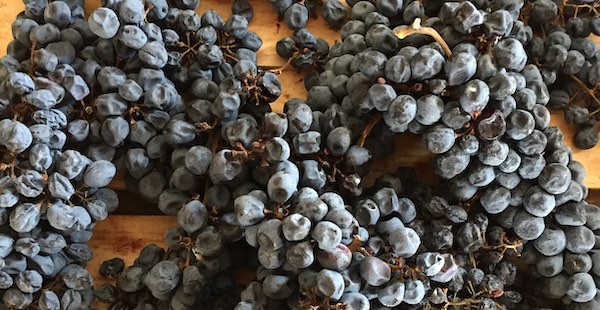
The roots of Amarone history extend back into ancient Roman times
and beyond. Cato the Censor (234–149 BC), Pliny the Elder (23–79
AD) and Suetonius (69 - 122 AD) all wrote about vinum
raeticum, the wine from Raetia, the
region in northern Italy that included Verona, and whose grapes
could only thrive when grown in the valleys around the city.
Apparently the emperor Augustus loved it.
 In
5th century AD Cassiodorus, minister of Theoderic the Great, king
of the Visigoths, in one of his letters wrote about a very
special sweet wine named Acinatico,
made not far from Verona with semi-dried grapes. Cassiodorus was
definitely talking about Recioto, the dessert
wine still produced today and considered the ancestor of
Amarone.
In
5th century AD Cassiodorus, minister of Theoderic the Great, king
of the Visigoths, in one of his letters wrote about a very
special sweet wine named Acinatico,
made not far from Verona with semi-dried grapes. Cassiodorus was
definitely talking about Recioto, the dessert
wine still produced today and considered the ancestor of
Amarone.
Making sweet wine with old techniques wasn't easy. They had to
move the wine from one vat to another hoping that all the yeasts
remained on the bottom, thus stopping the fermentation and leaving
a higher residual sugar in the final product. Nevertheless yeasts
sometimes remained and fermentation gradually continued ending up
in a dry wine. If your palate feels dryness while your brain
expects sweetness, the first sensation will be of a bitter wine, "amaro"
in Italian.
The legend says that in 1930s the wine maker of
Villa Novare forgot a barrel of Recioto in the cellar.
A few years later he realized his mistake, tasted the wine and
yelled that that wasn't a bitter wine (amaro in Italian)
but a great bitter wine: "Amarone!" (in Italian the ending "one"
is an augmentative and ameliorative). Gradually they started
producing Amarone intentionally and, as consumers palate changed
appreciating dry wines more than sweet ones, Amarone slowly
replaced Recioto in popularity becoming the most important product
of Valpolicella.
Wine Making
Grape Varietals and Selection
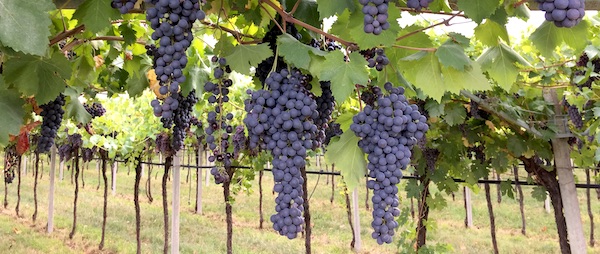
All Valpolicella wines, including Amarone, are made with a blend
of traditional local grape varietals: Corvina,
Corvinone (a clone of Corvina with bigger
berries) and Rondinella. The Corvina grapes
generally account for 60-80% of the blend, while Rondinella is
around 20-30%. Each wine maker has also the possibility allowed by
the production regulations of the DOCG (the
denomination authority), to add up to 15% of additional varietals
chosen from a list of approved grapes. These typically include the
indigenous Molinara, Oseleta,
Negrara, Pelara, Forsellina, etc. and even few other Italian and
international ones.
One of the most important moment in the production of Amarone is
the selection of the grapes during the harvest,
that typically takes place between mid-September and mid-October.
In order to sustain the drying process without rotting, clusters
must to be fully ripe, with perfectly intact skin, not too big and
loosely packed so that air is allowed to circulate inside the
cluster. That is why it is fundamental that harvest is done by
hand by experienced staff.
Appassimento
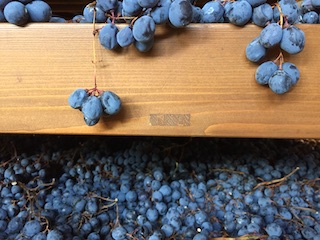 What
makes Amarone such a unique wine is a very special wine making
technique called Appassimento:
literally "withering". After picking, grapes are
laid on plastic or wooden trays, or on traditional racks made
of river reeds ("arele"),
always in a single layer to avoid overlapping of clusters that
could damage berries and reduce the uniformity of drying. Crates
full of grapes are stacked and left to dry for around 100 days in
"fruttaio", large, well
ventilated lofts above wine cellars. Grapes picked in
September remain on drying racks until January, a period in which
the weight of grapes is reduced by half, the acidity decreases and
sugar content rises by 30%.
What
makes Amarone such a unique wine is a very special wine making
technique called Appassimento:
literally "withering". After picking, grapes are
laid on plastic or wooden trays, or on traditional racks made
of river reeds ("arele"),
always in a single layer to avoid overlapping of clusters that
could damage berries and reduce the uniformity of drying. Crates
full of grapes are stacked and left to dry for around 100 days in
"fruttaio", large, well
ventilated lofts above wine cellars. Grapes picked in
September remain on drying racks until January, a period in which
the weight of grapes is reduced by half, the acidity decreases and
sugar content rises by 30%.
This is also the best period to schedule a wine tour in
Valpolicella. You will be able to see all the stages of
the production: harvest with the selection of the clusters and
fragrant drying lofts that gradually fill with grapes.
Thank to appassimento grapes not only concentrate sugar,
poliphenols and glycerin but also develop additional aromatic
substances that are unique to Valpolicella varietals.
When grapes reach the optimum point of concentration they are crushed.
Since fermentation takes generally place in
January when temperatures are low, it is a very slow process, with
a long skin contact that gives Amarone its beautiful deep color,
flavors and perfumes.
Barrel Ageing
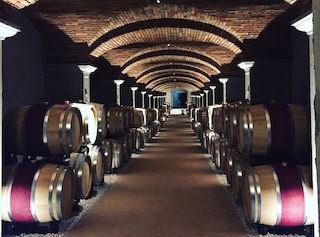 After
fermentation and decanting, the aging process is
another fundamental part in the making of Amarone. It is generally
done in traditional big Slavonia oak casks of
minimum 25 hectoliters, or in French oak 225 liters
barriques, although there are few producers that are
experimenting with American oak, cherry wood barrels, chestnut,
acacia, etc.
After
fermentation and decanting, the aging process is
another fundamental part in the making of Amarone. It is generally
done in traditional big Slavonia oak casks of
minimum 25 hectoliters, or in French oak 225 liters
barriques, although there are few producers that are
experimenting with American oak, cherry wood barrels, chestnut,
acacia, etc.
During the tour of an Amarone winery it is always a very thrilling
moment entering the underground cellars with the multitude of
small barriques or the huge traditional casks that can have
capacities of 10,000 liters or even more.
According to production regulations, Amarone must age in barrels a
minimum of two years, but most quality producers leave the wine
for 3, 5 years or even more in order to achieve more complexity,
smoothness and longevity.
Tasting, Pairing, Storage
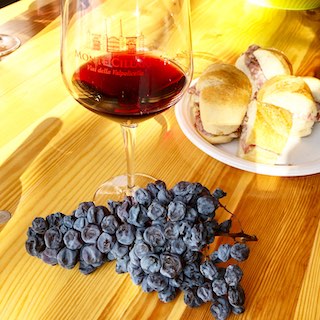 Thank
to these producing methods Amarone becomes an absolutely unique
and inimitable wine, with an intense color and aromas that for
young vintages remind of cherry, redcurrant
jam, chocolate, licorice
and, in older bottles, evolve into tobacco, coffee,
leather, spices and earthy
aromas. The palate is rich, full bodied and yet soft,
round an balanced.
Thank
to these producing methods Amarone becomes an absolutely unique
and inimitable wine, with an intense color and aromas that for
young vintages remind of cherry, redcurrant
jam, chocolate, licorice
and, in older bottles, evolve into tobacco, coffee,
leather, spices and earthy
aromas. The palate is rich, full bodied and yet soft,
round an balanced.
Pairing Amarone with food depends a lot on the style of the
winery. Elegant Amarones can be paired with
almost anything, from a pasta with a rich sauce, to a nice juicy
steak. Powerful Amarones need more intense food
like game, braised meat with a spicy gravy, longed aged cheese. An
old vintage or a particularly complex Amarone is
probably better on its own, just to enjoy the wine without pairing
it with food that could cover some of its multiple nuances. In
Italian they call this type of bottle "meditation wine".
Unlike some of the great Italian red wines like Barolo or Brunello
that need long ageing in bottle to soften the harsh tannins,
Amarone is a very enjoyable wine from the very beginning, but it
also has an incredible longevity in the cellar.
Amarone will continue to evolve, getting even smoother and more
complex after 10, 15 or, for outstanding vintages, 20 or more
years.
Cellar Tours
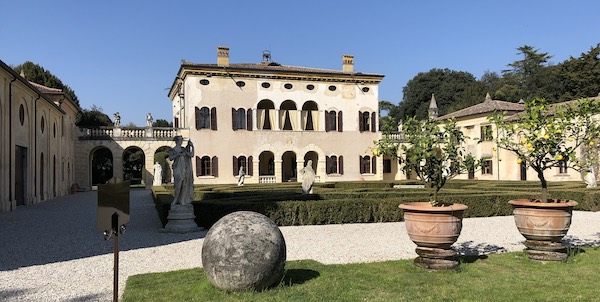
Nowadays there are more than 350 wineries in Valpolicella.
They range from big companies producing millions of bottles per
year in modern plants using cutting-edge technologies (Masi,
Tommasi, Sartori, Pasqua, Allegrini), to small, family
run wineries still using traditional methods in
creating craftsman like wine (Meroni, Vogadori, Valentina 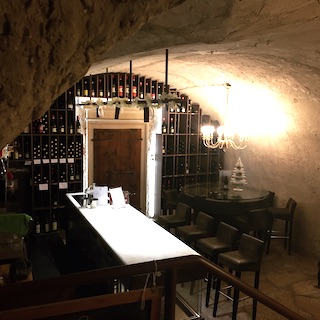 Cubi,
Marognole, Le Bignele), or even historical cellars
inside gorgeous Renaissance and Baroque style villas
(Mosconi Bertani, Santa Sofia, Guerrieri Rizzardi, Serego
Alighieri).
Cubi,
Marognole, Le Bignele), or even historical cellars
inside gorgeous Renaissance and Baroque style villas
(Mosconi Bertani, Santa Sofia, Guerrieri Rizzardi, Serego
Alighieri).
In our wine tours, unless we have specific requests from clients,
we select wineries trying to show our guests this wide
variety of styles and different wine making
approaches. Let us know what type of wine you like and
we will able to select cellars for the tour to suit your personal
taste.
The tour in a winery includes a walk in
the vineyards, a visit to grapes drying lofts,
barrel cellars and a tasting of a
selection of Valpolicella and Amarone wines. An
English speaking, wine expert guide will allow you to interact
with cellar owners and wine makers.
For any further information on itineraries in Valpolicella wineries or to book a wine tour in any producing areas around Verona please also check www.amaronetours.it or send us an email:
